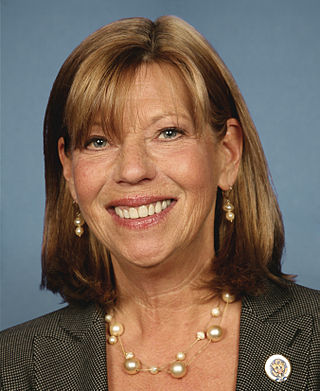A utility cooperative is a type of cooperative that is tasked with the delivery of a public utility such as electricity, water or telecommunications to its members. Profits are either reinvested for infrastructure or distributed to members in the form of "patronage" or "capital credits", which are dividends paid on a member's investment in the cooperative.

Jo Ann Emerson is an American politician who was the U.S. representative for Missouri's 8th congressional district from 1996 to 2013. The district consists of Southeast and South Central Missouri and includes the Bootheel, the Lead Belt and the Ozarks. Emerson is a member of the Republican Party. On January 22, 2013, Emerson resigned her seat in Congress to become the president and chief executive officer of the National Rural Electric Cooperative Association. She served as CEO until August 2015.

Rural electrification is the process of bringing electrical power to rural and remote areas. Rural communities are suffering from colossal market failures as the national grids fall short of their demand for electricity. As of 2019, 770 million people live without access to electricity – 10.2% of the global population. Electrification typically begins in cities and towns and gradually extends to rural areas, however, this process often runs into obstacles in developing nations. Expanding the national grid is expensive and countries consistently lack the capital to grow their current infrastructure. Additionally, amortizing capital costs to reduce the unit cost of each hook-up is harder to do in lightly populated areas. If countries are able to overcome these obstacles and reach nationwide electrification, rural communities will be able to reap considerable amounts of economic and social development.
Touchstone Energy Cooperatives is a cooperative federation composed of more than 750 local, consumer-owned utility cooperatives in 46 states in the United States. Touchstone Energy co-ops serve more than 30 million members.
Basin Electric Power Cooperative is a wholesale electric generation and transmission cooperative based in North Dakota that provides electricity to 3 million customers in nine U.S. states. The roots of the cooperative go back to 1960 when Leland Olds and ten power suppliers created Giant Power Cooperative. Giant Power was first going to be a generation and transmission cooperative, but to keep electricity cheaper for rural customers, Basin Electric Power Cooperative was started in 1961. Today, Basin Electric's power sources include coal, natural gas, hydroelectric, wind, waste heat, and nuclear. The current CEO and General Manager is Todd Telesz. A subsidiary of Basin Electric, Dakota Gasification Company, operates the Great Plains Synfuels Plant, which captures and sequesters nearly 50% of its carbon dioxide emissions in a system developed during the Carter administration. In 2005, the membership of Basin Electric passed a resolution requiring 10 percent of electricity demand to be provided by renewable forms of energy. At the end of 2009, Basin Electric finished construction on a 77 turbine wind energy project.

Viasat is an American communications company based in Carlsbad, California, with additional operations across the United States and worldwide. Viasat is a provider of high-speed satellite broadband services and secure networking systems covering military and commercial markets.

Great River Energy is an electric transmission and generation cooperative in the U.S. state of Minnesota; it is the state's second largest electric utility, based on generating capacity, and the fifth largest generation and transmission cooperative in the U.S. in terms of assets. Great River Energy was formed in 1999 when Cooperative Power Association and United Power Association merged.

The electricity sector in Colombia is dominated by large hydropower generation (65%) and thermal generation (35%). Despite the country's large potential for new renewable energy technologies, this potential has been barely tapped. A 2001 law designed to promote alternative energies lacks certain key provisions to achieve this objective, such as feed-in tariffs, and has had little impact so far. Large hydropower and thermal plants dominate the current expansion plans. The construction of a transmission line with Panama, which will link Colombia with Central America, is underway.
Wiregrass Electric Cooperative is a not-for-profit rural electric utility cooperative headquartered in Hartford, Alabama. It is a member of the Alabama Rural Electric Association of Cooperatives (AREA) and the National Rural Electric Cooperative Association.

The Internet in Ukraine is well developed and steadily growing, mostly uninfluenced by the global financial crisis; in April 2012 rapid growth was forecast for at least two more years. As of 2011, Ukraine was ranked 9th in the "Top 10 Internet countries in Europe", with then 33.9% Internet penetration and 15.3 million users; growing to 36.8% in 2012. However, as of January 2021 about 30 million Ukrainians were Internet users.
Brazil has the largest electricity sector in Latin America. Its capacity at the end of 2021 was 181,532 MW. The installed capacity grew from 11,000 MW in 1970 with an average yearly growth of 5.8% per year. Brazil has the largest capacity for water storage in the world, being dependent on hydroelectricity generation capacity, which meets over 60% of its electricity demand. The national grid runs at 60 Hz and is powered 83% from renewable sources. This dependence on hydropower makes Brazil vulnerable to power supply shortages in drought years, as was demonstrated by the 2001–2002 energy crisis.
The National Rural Utilities Cooperative Finance Corporation (CFC) is a member-owned nonprofit cooperative that provides financial products to America's rural electric cooperative network. CFC was established in 1969 to raise funds from the capital markets to supplement the loan programs for electric cooperatives offered by the U.S. Department of Agriculture’s (USDA) Rural Utilities Service (RUS), previously Rural Electrification Administration (REA).
Vermont electric power needs are served by over twenty utilities. The largest is Green Mountain Power, a subsidiary of Énergir which recently also took over Central Vermont Public Service. Together this single company represents 70% of the retail customers in Vermont. The state is a small electricity consumer compared with other states. Therefore, its electricity sector has the lowest carbon footprint in the country. As of 2010, the state had the lowest wholesale electricity costs in New England. Efficiency Vermont engages in aggressive initiatives to cut residential electricity waste, which often identifies other problems that it claims can save hundreds per household per year. Accordingly, Vermont's overall energy bills are also relatively lower than in the rest of the New England states.
The United States state of Arkansas is a significant producer of natural gas and a minor producer of petroleum.
First Electric Cooperative is a non-profit rural electric utility cooperative headquartered in Jacksonville, Arkansas. The cooperative was organized April 26, 1937, as the first electric cooperative in Arkansas under the federal Rural Electrification Act of 1935. The cooperative energized its first lines April 15, 1938, near Jacksonville with three employees and 150 members.

Starlink is a satellite internet constellation operated by American aerospace company SpaceX, providing coverage to over 70 countries. It also aims for global mobile phone service after 2023.

Allegheny Electric Cooperative is an electric generation and transmission cooperative that generates electricity for 14 member electric cooperatives in the states of Pennsylvania and New Jersey in the United States. The cooperative, which was founded in 1946, is based in Harrisburg, Pennsylvania.
Meriwether Lewis Electric Cooperative is a non-profit, member owned utility cooperative that provides electric power service and internet services to rural communities in western Middle Tennessee. It is a 501(c)(12) organization, and is headquartered in Centerville, Tennessee. It was established in 1939 under the Tennessee Electric Cooperative Act of 1939, and also holds a government-granted monopoly on electric power distribution within its service area, which includes Hickman, Houston, Humphreys, Lewis, and Perry counties. It is named after American explorer Meriwether Lewis, who is buried in its service area. MLEC is a part of the Touchstone Energy cooperative federation.








